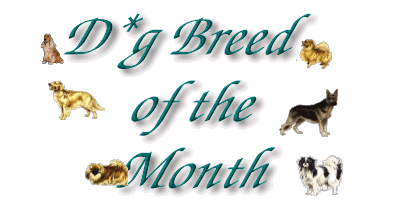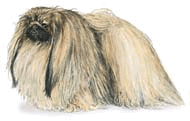

Welcome kitties!
We have added a new activity for you all to take part in and earn points. This will be an ongoing monthly activity, so you will have the chance to earn 20 points each time you participate.
What we will be be doing is reading about a particular d*g breed and then answering some questions about that breed. That's it! You will be having fun and learning something new each month.
Ready to read about this month's breed?
Here we go!
![]()

The Pekingese
General Appearance
The Pekingese is a well-balanced, compact dog with heavy front
and lighter hindquarters. It must suggest its Chinese origin in
its directness, independence, individuality and expression. Its
image is lionlike. It should imply courage, boldness and
self-esteem rather than prettiness, daintiness or delicacy.
Size, Substance, Proportion
Size/Substance The Pekingese should be surprisingly heavy
when lifted. It has a stocky, muscular body. The bone of the
forequarters must be very heavy in relation to the size of the
dog. All weights are correct within the limit of 14 pounds,
provided that type and points are not sacrificed.
Disqualification: weight over 14 pounds. Proportion The
length of the body, from the front of the breast bone in a
straight line to the buttocks, is slightly greater than the
height at the withers. Overall balance is of utmost importance
Head
Skull The topskull is massive, broad and flat (not
dome-shaped). The topskull, the high, wide cheek bones, broad
lower jaw and wide chin are the structural formation of the
correctly shaped face. When viewed frontally, the skull is wider
than deep and contributes to the rectangular envelope-shaped
appearance of the head. In profile, the Pekingese face must be
flat. The chin, nose leather and brow all lie in one plane. In
the natural position of the head, this plane appears vertical but
slants very slightly backward from chin to forehead. Nose
It is black, broad, very short and in profile, contributes to the
flat appearance of the face. Nostrils are open. The nose is
positioned between the eyes so that a line drawn horizontally
across the top of the nose intersects the center of the eyes. Eyes
They are large, very dark, round, lustrous and set wide apart.
The look is bold, not bulging. The eye rims are black and the
white of the eye does not show when the dog is looking straight
ahead. Wrinkle It effectively separates the upper and
lower areas of the face. The appearance is of a hair covered fold
of skin, extending from one cheek, over the bridge of the nose in
a wide inverted "V", to the other cheek. It is NEVER so
prominent or heavy as to crowd the facial features nor to obscure
a large portion of the eyes or the nose from view. Stop It
is deep. The bridge of the nose is completely obscured from view
by hair and/or the over-nose wrinkle. Muzzle This is very
short and broad with high, wide cheek bones. The color of the
skin is black. Whiskers add to the Oriental expression.Mouth
The lower jaw is slightly undershot. The lips meet on a level
plane and neither teeth nor tongue show when the mouth is closed.
The lower jaw is strong, wide, firm and straight across at the
chin. An excessively strong chin is as undesirable as a weak one.Ears
They are heart-shaped and set on the front corners of the skull
extending the line of the topskull. Correctly placed ears frame
the sides of the face and with their heavy feathering create an
illusion of additional width of the head.Pigment The skin
of the nose, lips and eye rims is black on all colors.
Neck, Body, Tail
Neck It is very short, thick and set back into the
shoulder. Body This is pear-shaped and compact. It is
heavy in front with well-sprung ribs slung between the forelegs.
The broad chest, with little or no protruding breast bone, tapers
to lighter loins with a distinct waist. The topline is level. Tail
The base is set high; the remainder is carried well over the
center of the back. Long, profuse straight feathering may fall to
either side.
Forequarters
They are short, thick and heavy-boned. The bones of the forelegs
are slightly bowed between the pastern and elbow. Shoulders are
gently laid back and fit smoothly into the body. The elbows are
always close to the body. Front feet are large, flat and turned
slightly out. The dog must stand well up on feet.
Hindquarters
They are lighter in bone than the forequarters. There is moderate
angulation and definition of stifle and hock. When viewed from
behind, the rear legs are reasonably close and parallel and the
feet point straight ahead. Soundness is essential in both
forequarters and hindquarters.
Coat
Body Coat It is full-bodied, with long, coarse textured,
straight, stand-off coat and thick, softer undercoat. The coat
forms a noticeable mane on the neck and shoulder area with the
coat on the remainder of the body somewhat shorter in length. A
long and profuse coat is desirable providing that it does not
obscure the shapeliness of the body, nor sacrifice the correct
coat texture. Feathering Long feathering is found on the
back of the thighs and forelegs, and on the ears, tail and toes.
The feathering is left on the toes but should not be so long as
to prevent free movement.
Color
All coat colors and markings, including parti-colors, are
allowable and of equal merit.
Gait
The gait is unhurried and dignified, with a slight roll over the
shoulders. The rolling gait is caused by the bowed front legs and
heavier, wider forequarters pivoting on the tapered waist and the
lighter, straight parallel hindquarters. The rolling motion is
smooth and effortless and is as free as possible from bouncing,
prancing or jarring.
Temperament
A combination of regal dignity, self-importance, self-confidence
and exasperating stubbornness make for a good natured, lively and
affectionate companion to those who have earned its respect.
The foregoing is a description of the ideal Pekingese. Any
deviation should be penalized in direct proportion to the extent
of that deviation.
FAULTS TO BE NOTED
DUDLEY, LIVER OR GRAY NOSE.
LIGHT BROWN, YELLOW OR BLUE EYES.
PROTRUDING TONGUE OR TEETH.
OVERSHOT UPPER JAW.
WRY MOUTH.
EARS SET MUCH TOO HIGH, LOW OR FAR BACK.
ROACH OR SWAYBACK.
STRAIGHT-BONED FORELEGS.
![]()
Now you heve read all about the Pekingese
Read the questions and then MEW to me the answers
1. Discribe this d*gs coat
2.What is his muzzle like?
3. What kind of tail has he?
That's it!
Good luck kitties. I hope you had fun and learned something new!
***KITTIES WHO HAVE ANSWEWED***
Nikita La Femme
Nikki
Nichie
Buddah Gill
Tamara
Frodo Lehmann
SEE SOME REAL PEKES
Thanks to Sir Wally, Cheyanne Autumn, and Silvermyst